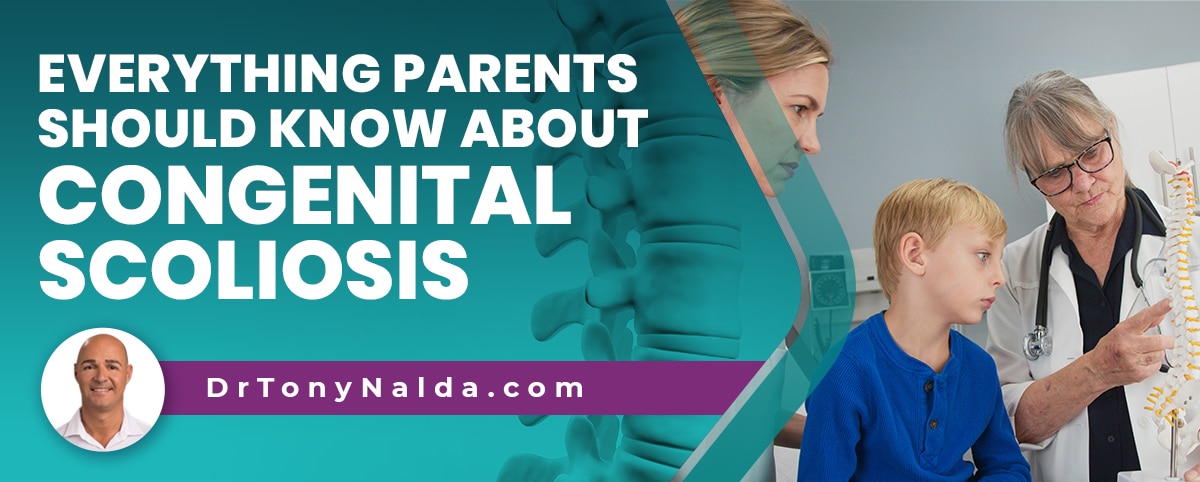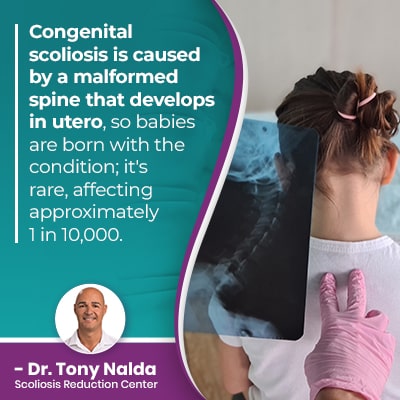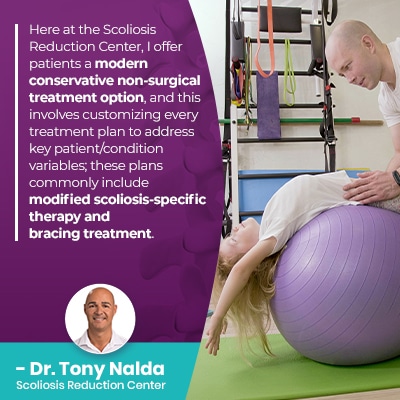Everything Parents Should Know About Congenital Scoliosis

Scoliosis in children should be taken seriously. There is a lot we don't know about the condition, but we do know that it's progressive and progression is triggered by growth and development. Young patients whose spines are still growing are at the highest risk for continued and rapid progression. Children with congenital scoliosis commonly have other malformed parts/systems within the body.
Scoliosis doesn't just range widely in severity from mild to very severe, there are also different types that can develop. Scoliosis affects all ages, but is more common in children. Babies born with scoliosis have congenital scoliosis, caused by a malformed spine that developed in utero.
Before getting to the specifics of congenital scoliosis, let's first talk about how scoliosis affects the spine and body.
Table of Contents
Understanding the Scoliotic Spine
As such a highly-prevalent spinal condition, scoliosis awareness is important; while there are never treatment guarantees, in patients who have achieved early detection and responded with a proactive treatment approach, there are fewer limits to what can be achieved.
Scoliosis involves the development of an unnatural sideways curvature of the spine, and a scoliotic spine doesn't just bend unnaturally to the side, it also rotates, making scoliosis a 3-dimensional condition.
Scoliosis causes the spine to become misaligned as certain vertebral bodies become excessively tilted, and this disrupts the biomechanics of the entire spine, causing the spine to become unstable.
So scoliosis introduces a lot of uneven forces to the spine, its surrounding muscles, nerves, and the entire body.
Part of diagnosing scoliosis at any age involves comprehensive assessment so conditions can be further classified based on key patient/condition variables, two of which are patient age and condition type, and type is determined by causation; let's talk about why those variables are important.
Patient Age
Patient age is important for two main reasons: pain and progression.
Scoliosis isn't commonly painful for children, and this is because it doesn't become a compressive condition until skeletal maturity has been reached.
In children whose spines are still growing, the constant lengthening motion of a growing spine counteracts the compressive force of the unnatural spinal curve, and it's compression of the spine and its surrounding muscles and nerves that causes the majority of condition-related pain.
So patient age is a good indication of whether or not pain management is going to need to be a focus of treatment; in adult scoliosis, pain is the main symptom, and in children, it's postural changes.
Postural changes will vary based on condition severity and how much rotation there is in the spine, but common changes can include uneven shoulders, shoulder blades, the development of a rib cage arch, uneven hips, and more.
In addition, changes to gait, balance, and coordination are also common.
Patient age is also an important predictor of progressive rates; as a progressive condition, scoliosis has it in its nature to worsen over time, and this makes the condition more complex to treat, and a child's growth is what triggers their scoliosis to get worse.
So mild curves can easily progress and become moderate and severe curves, which is what treatment strives to avoid.
So babies born with scoliosis are at risk for continued progression triggered by growth and development, and now, let's talk about condition type.
Different Types of Scoliosis
Part of the reason the complex nature of scoliosis necessitates the customization of effective treatment plans is because no two cases are the same; scoliosis affects all ages, but is more common in children, ranges from mild to very severe, can involve different types/patterns of scoliotic curves, and there are also multiple different types of scoliosis.
Condition type is important because it's a condition's underlying cause that has to be the focus of treatment; otherwise, only a condition's symptoms are being addressed, not their underlying cause: the condition itself.
The most common type of scoliosis to affect both children and adults is idiopathic scoliosis, meaning the cause is unknown, and idiopathic scoliosis accounts for approximately 80 percent of known diagnosed cases, and the remaining 20 percent are associated with known causes.
Neuromuscular scoliosis, degenerative scoliosis, and congenital scoliosis are considered atypical because their causation is known.
Neuromuscular scoliosis is caused by the presence of a larger neuromuscular condition such as spina bifida, muscular dystrophy, and cerebral palsy.
Degenerative scoliosis is caused by natural related spinal degeneration and the cumulative effect of certain lifestyle choices.
And that brings us to congenital scoliosis.
Congenital Scoliosis
 Congenital scoliosis is caused by a malformed spine that develops in utero, so babies are born with the condition; it's rare, affecting approximately 1 in 10,000.
Congenital scoliosis is caused by a malformed spine that develops in utero, so babies are born with the condition; it's rare, affecting approximately 1 in 10,000.
When scoliosis affects newborns, it's known that these patients are in need of comprehensive assessment because they commonly present with other congenital abnormalities due to abnormal development; this is something parents need to know and fully understand.
Congenital scoliosis patients are commonly diagnosed during the initial newborn physical examination of the child's spine, and accompanying issues can include congenital heart defects and lung impairment.
Thoracic insufficiency syndrome can cause fused ribs as the thoracic deformity is 3-dimensional and affects thoracic growth and function; the thoracic spine is the largest of the three main spinal sections and consists of the middle/upper back.
A limited chest volume interferes with lung growth, causing lung impairment, and this is also related to thoracic insufficiency syndrome.
The spine not forming properly is what causes congenital scoliosis, and two common vertebral malformations include one or more of the spine's vertebrae (bones) being triangular in shape, instead of rectangular, causing the spine to wedge forward and develop abnormal curves.
Another common cause of an abnormal curvature of the spine in babies is when separate vertebrae fuse together, instead of forming into distinct and separate bones, causing the development of bony spinal segments.
Congenital Scoliosis Treatment
Typical cases of scoliosis are idiopathic, and as congenital scoliosis falls under the umbrella of scoliosis types with known causes, it's considered atypical.
In addition, typical cases of scoliosis have curves that bend to the right, away from the heart, and atypical types can have curves that bend to the left, towards the heart, and this is why related congenital heart defects are common.
When I see a scoliotic curve that bends to the left, this is a red flag that there is an underlying pathology causing the condition's development, such as a congenital spinal deformity.
Atypical types of scoliosis complicate the treatment process because the condition's underlying cause has to be the focus of treatment, and in congenital scoliosis, there are obvious challenges associated with treating patients of such a young age.
The unfortunate reality is that because these cases are atypical, can involve atypical curve patterns, and are often accompanied by additional congenital anomalies, they tend to involve severe deformity, making curve progression with growth even more likely, and curve correction even more complicated.
 Traditional scoliosis treatment offers a surgical treatment response, while conservative treatment offers a non-surgical treatment alternative.
Traditional scoliosis treatment offers a surgical treatment response, while conservative treatment offers a non-surgical treatment alternative.
Surgical treatment involves spinal fusion, and this is a lengthy, costly, and invasive procedure; non-surgical treatment finds a balance between observation and action, as there is no definitive means by which whether or not a baby will progress, and at what rate, can be determined.
If a curve progresses past 25 degrees (moderate scoliosis), it's likely that spinal growth will trigger continued progression, and it's simpler to treat smaller curves.
X-rays are an important part of observing what's happening in and around the spine and monitoring how it's responding to growth, and this is not always possible with babies, so treatment plans and approaches have to be modified to account for these unique challenges.
Here at the Scoliosis Reduction Center, I offer patients a modern conservative non-surgical treatment option, and this involves customizing every treatment plan to address key patient/condition variables; these plans commonly include modified scoliosis-specific therapy and bracing treatment.
The goal of treatment is to stay ahead of the curve's progression and help patients avoid the risks associated with scoliosis surgery.
Conclusion
Congenital scoliosis occurs in babies who are born with the condition due to abnormal spine formation; this is a structural spinal deformity that is often accompanied by additional congenital abnormalities.
The most important condition characteristic parents need to understand is the progressive nature of scoliosis; it's virtually guaranteed to get worse over time.
Being proactive with treatment can have many benefits, including addressing a scoliotic curve while it's mild, before it progresses to moderate, severe, or a very severe deformity, and before the body has had time to adjust to its presence, making condition effects more established.
As progression is triggered by growth and development, children are at a higher risk for continued and rapid progression, which is why congenital scoliosis diagnosed needs to be taken seriously.
Dr. Tony Nalda
DOCTOR OF CHIROPRACTIC
After receiving an undergraduate degree in psychology and his Doctorate of Chiropractic from Life University, Dr. Nalda settled in Celebration, Florida and proceeded to build one of Central Florida’s most successful chiropractic clinics.
His experience with patients suffering from scoliosis, and the confusion and frustration they faced, led him to seek a specialty in scoliosis care. In 2006 he completed his Intensive Care Certification from CLEAR Institute, a leading scoliosis educational and certification center.
About Dr. Tony Nalda
 Ready to explore scoliosis treatment? Contact Us Now
Ready to explore scoliosis treatment? Contact Us Now





